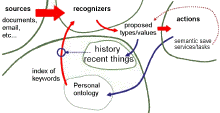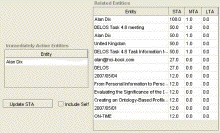References
- Amann, B. & Fundulaki, I., (1999). Integrating Ontologies and Thesauri to Build RDF Schemas, Proceedings of the Third European Conference on Research and Advanced Technology for Digital Libraries, pp. 234 – 253
- Anderson, J. R. (1983). A spreading activation theory of memory. Journal of Verbal Learning and Verbal Behaviour, 22, pp. 261-295
- Anderson, J. R. (1995), Cognitive Psychology and its Implications, Worth Publishers, 5th Edition.
- Atkinson, R.C. & Shiffrin, R.M. (1968) Human memory: A proposed system and its control processes. In K.W. Spence and J.T. Spence (Eds.), The psychology of learning and motivation, vol. 8. London: Academic Press.
- Catarci, T., Dix, A., Katifori, A., Lepouras, G. & Poggi A., (2007). Task-Centered Information Management. Proceedings of the DELOS Conference 2007 on Working Notes, 13-14 February 2007, Tirrenia, Pisa (Italy), C. Thanos and F. Borri (eds.). pp. 253-263.
- Catarci, T., Habegger, B., Poggi, A., Dix, A., Ioannidis, Y., Katifori, A. & Lepouras, G., (2006). Intelligent user task oriented systems. In Proc. of the Second SIGIR Workshop on Personal Information Management (PIM 2006), 2006.
- Chirita, P. A., Gavriloai, R., Ghita, S., Nejdl, W. & Paiu, R. (2005). Activity Based Metadata for Semantic Desktop Search, Proceedings of the 2nd European Semantic Web Conference.
- Corcho, O. & Gómez – Pérez, A. (2000). A roadmap to ontology specification languages, Proceedings of the 12th International Conference on Knowledge Aquisition, Modelling and Management (EKAW), 2000, Springer.
- Crestani F. (1997b). Application of spreading activation techniques in information retrieval. Artificial Intelligence Review, 11(6):453–482, December 1997.
- Crestani, F. (1997a). Retrieving documents by constrained spreading activation on automatically constructed hypertexts. In Proceedings of EU- FIT 97- Fifth International Congress on Intelligent Techniques and Soft Computing, pp. 1210-1214, Aachen, Germany.
- Dix, A. (2006). The brain and the web - intelligent interactions from the desktop to the world. Keynote at Simpósio de Fatores Humanos em Sistemas Computacionais (IHC 2006), Natal Brazil, 19-22 Nov. 2006. Retrieved from http://www.hcibook.com/alan/papers/brazil2006/
- Dix, A., Katifori, A., Poggi, A., Catarci, T., Ioannidis, Y., Lepouras, G. & Mora, M., (2007). From Information to Interaction: in Pursuit of Task-centred Information Management. Proceedings of the DELOS Conference 2007, December 2007, Tirrenia, Pisa (Italy).
- Ericsson, K. A., & Kintsch, W. (1995). Long-term working memory. Psychological Review, 102, 211-245.
- Facebook, (2008). Facebook home page. Retrieved from http://www.facebook.com/, February 13, 2008.
- Gauch, S., Chaffee, J. & Pretschner, A., (2003). Ontology-Based User Profiles for Search and Browsing, User Modeling and User-Adapted Interaction, The Journal of Personalization Research, Special Issue on User Modeling for Web and Hypermedia Information Retrieval.
- Gauch, S., Chaffee, J. & Pretschner, A., (2003). Ontology-Based User Profiles for Search and Browsing, User Modeling and User-Adapted Interaction, The Journal of Personalization Research, Special Issue on User Modeling for Web and Hypermedia Information Retrieval.
- Gazzaniga, M. S., Ivry, R. B. & Mangun, G. R., (1998) Cognitive Neuroscience, The Biology of the Mind, pp 289-294, W. W. Norton & Company, New Ed edition (April 1998)
- Golemati, M., Katifori, A., Vassilakis, C., Lepouras, G. & Halatsis, C., (2007). Creating an Ontology for the User Profile: Method and Applications, Proceedings of the First RCIS Conference, April 23-26, 2007, Ouarzazate, Morocco.
- Gruber, T. R. (1993a). Toward principles for the design of ontologies used for knowledge sharing. Originally in N. Guarino and R. Poli, (Eds.), International Workshop on Formal Ontology, Padova, Italy, 1993. Revised August 1993. Published in International Journal of Human-Computer Studies, Volume 43 , Issue 5-6 Nov./Dec. 1995, pp. 907-928
- Gruber, T. R., (1993b). A Translation Approach to Portable Ontology Specifications, Knowledge Acquisition, Special issue: Current issues in knowledge modelling, Vol 5, Issue 2, pp. 199-220.
- Hasan, M. (2003). A Spreading Activation Framework for Ontology-enhanced Adaptive Information Access within Organisations. In Proceedings of the Spring Symposium on Agent Mediated Knowledge Management AMKM 2003, Stanford University, California, USA
- Hopfield, J. (1982). Neural networks and physical systems with emergent collective computational properties. Proceedings of the National Academy of Sciences of the USA, 79:2554 - 2588.
- ICQ (2008). ICQ home page. Retrieved from http://www.icq.com, February 12, 2008
- Katifori, A., (2008). Preliminary Evaluation Example of the Spreading Activation Algorithm. Pened technical report TR-08-01. Retrieved from http://oceanis.mm.di.uoa.gr/pened/?c=pub#tr, February 21, 2008.
- Katifori, A., Dix, A. & Vassilakis, C., (2008), Spreading activation Protégé plugin. Retrieved from http://oceanis.mm.di.uoa.gr/pened/?c=pub#plugins, February 02, 2008.
- Katifori, A., Torou, E., Halatsis, C., Lepouras, G. & Vassilakis, C., (2006). A Comparative Study of Four Ontology Visualization Techniques in Protégé: Experiment Setup and Preliminary Results, Proceedings of the IV 06 Conference.
- Katifori, A., Vassilakis, C., Dix, A., Daradimos, I. & Lepouras, G., (2007). Spreading Activation User profile ontology. Retrieved from http://oceanis.mm.di.uoa.gr/pened/index.php?category=publications#ontos, February 2, 2008.
- Katifori, A., Vassilakis, C. & Dix, A., (2008). Using Spreading Activation through Ontologies to Support Personal Information Management. Proceedings of Common Sense Knowledge and Goal-Oriented Interfaces, held in conjunction with the 2008 International Conference on Intelligent User Interfaces (IUI 2008).
- Katifori, V., Poggi, A., Scannapieco, M., Catarci, T. & Ioannidis, Y., (2005). OntoPIM: how to rely on a personal ontology for Personal Information Management, Proc. of the 1st Workshop on The Semantic Desktop, 2005.
- Kobsa, A. (1993). User Modelling: Recent work, prospects and hazards, in Adaptive User Interfaces: Principles and Practices, edited by Schneider-Hufschmidt, T. Khme and U. Malinowski, North Holland.
- Lepouras, G., Dix, A., Katifori, A., Catarci, T., Habegger, B., Poggi, A. & Ioannidis, Y., (2006). OntoPIM: From Personal Information Management to Task Information Management, Proceedings of Personal Information Management, SIGIR 2006 workshop, August 10-11, 2006, Seattle, Washington.
- Liu, W., Weichselbraun, A., Scharl, A. & Chang, E., (2005). Semi-Automatic Ontology Extension Using Spreading Activation, Journal of Universal Knowledge Management, no. 1 (2005), pp. 50 - 58
- Lømo T. (2003). The discovery of long-term potentiation. Philosophical Transactions: Biological Sciences. 358 (1432): 617-20. PMID 12740104.
- Lorch, R. F., (1982). Priming and search processes in semantic memory: A test of tree models of spreading activation. Journal of Verbal Learning and Verbal Behavior, 8, pp. 240-248
- Maedche, A. & Staab, S. (2002). Mining Ontologies from Text, Proceedings of EKAW 2000, pp. 189-202, 2002.
- Microsoft Corporation, (2008). Windows Vista: Features Explained: Windows Sidebar and Gadgets. Retrieved from http://www.microsoft.com/windows/products/windowsvista/features/details/sidebargadgets.mspx February 13, 2008.
- Miller, G. A., (1990). WORDNET: An On-Line Lexical Database. International Journal of Lexicography 3–4, 1990, pp. 235–312.
- Miller, G., A. (1956). The Magical Number Seven, Plus or Minus Two: Some Limits on Our Capacity for Processing Information, The Psychological Review, vol. 63, pp. 81-97
- Mitchell T. M., (1997). Machine Learning, McGraw-Hill, 1997, ISBN 0-07-042807-7.
- MySpace, (2008). MySpace home page. Retrieved from http://www.myspace.com/, February 12, 2008.
- Noy, N. F. & McGuiness, D. L., (2001) Ontology Development 101: A Guide to Creating Your First Ontology, Stanford Knowledge Systems Laboratory Technical Report KSL-01-05 and Stanford Medical Informatics Technical Report SMI-2001-0880, 2001
- Peterson, L.R., & Peterson, M.J. (1959). Short-term retention of individual verbal items. Journal of Experimental Psychology, 58, 193-198.
- Protégé (2008). The Protégé Ontology Editor and Knowledge Acquisition System. Retrieved from http://protege.stanford.edu/, February 09, 2008.
- Reder, L. M. & Anderson J. R. (1980). A partial solution of the paradox of interference: The role of integrating knowledge. Cognitive Psychology, 12, 447-472
- Renato, I., (2001). Representing vCard Objects in RDF/XML. Retrieved from http://www.w3.org/TR/vcard-rdf, February 10, 2008.
- Sauermann, L. (2005). The Gnowsis Semantic Desktop for Information Integration, Proceedings of the 3rd Conference Professional Knowledge Management (WM 2005)
- Sharifian, F. & Samani, R. (1997), Hierarchical Spreading of activation, Proc. of the Conference on Language, Cognition and Interpretation, Isfahan, pp. 1-10
- Tazari, M. R., Grimm, M. & Finke, M. (2003). Modeling User Context, Proceedings of the 10th International Conference on Human-Computer Interaction (HCII2003), Crete, Greece, June 2003
- Trajkova, J. & Gauch, S. (2004). Improving Ontology-based User Profiles, Proceedings of RIAO 2004, University of Avignon (Vaucluse), France, April 26-28, 2004, pp. 380-389
- Vassilakis, C., Lepouras, G. & Katifori, A., (2007). wt-Protégé – An Extension for Protégé Supporting Temporal and Weighted Data, Technical Report TR-SSDBL-07-001, September 2007, Tripoli, Greece
- Xue, G. R., Zeng, H. J., Chen, Z., Ma, W. Y., Xi, W., Fan, W. & Yu, Y. (2004). Optimizing Web Search Using Web Click-through Data. Proceedings of CIKM 2004: 118-126
|
 |

[[full size]]
Figure 1. An overview of the personal ontology extended with class related to the researcher stereotype.

[[full size]]
Figure 2. The first levels of the slot hierarchy modeling person relations. The inverse slots are represented by Protégé with grey colour .

[[full size]]
Figure 3. Basic outline of a PIMS system.

[[full size]]
Figure 4. Part of the plug-in window showing the STA, MTA and LTA values for the entities that received STA activation value greater than 12, when entity “Alan Dix” got IA = 1.. |



